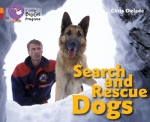Following on from our activity on helping animals we are now going to look in more detail at how animals help us; from providing food for us; company and companionship; working for us and saving lives. Why not invite organisations such as the police and fire service who visit schools with their animals to talk about their work?
Activity One – Speaking and Listening – Presenting
LO: Making and using effective notes
Talking about their interests
Talking Point: Begin by telling the children you’d like them to find out about an animal that helps us. Say that they are going to do a talk lasting between one and five minutes, depending on their age, about their chosen animal.
Having chosen their animal, they need to research how it helps people and write brief notes they can use to talk from. They can use visual aids but if they’re going to bring animals in, you’ll need to consider allergies and health and safety issues.
At Home: Ask the children to continue the preparation of their talks and practise them at home in readiness for the presentation.
Activity Two – Spelling and Vocabulary – Animals That Help Us
LO: To list words about a topic
To learn how to spell words from topic groups
Talking Point: Ask the children to think of jobs which animals do for us. They might suggest search and rescue, guide dogs, horses ploughing etc. List the relevant vocabulary that goes with the animal and ask the children to learn the words.
At Home: Learn the spellings
Activity Three – Writing Non-Fiction – Animals That Help Us
LO: Write for different purposes
Using the language of non-fiction
Select some non-fiction books from the school library about animals and read extracts to the children, asking them to think about the language used in the book or, if you have an interactive whiteboard, scan in some extracts and annotate them live with the children’s comments.
Talking Point: What kind of language was used in the extracts? Were there a lot of adjectives? Was there dialogue? How much description was there?
Now using either the computer or paper and pens, ask them to complete a piece of non-fiction work about a helpful animal. Ask them what kind of information they might include and what sections they might break it down into. They may suggest a ‘Did you know’, a list of organisations to contact, examples of when they’ve helped, etc. Ask them to consider the layout and what pictures they may want to include. They can use the same animal they used for their presentation if they want.
At Home: You can ask them to find illustrations to use in their work or to prepare drawings to stick in their work if doing it on paper.
Activity Four – Grammar – Question Words and Paired Verbs
LO: To use language and grammar effectively to achieve a purpose
To be able to pair verbs correctly with question words depending on number and tense
Talking Point: Ask the children some simple questions and get them to identify how they knew it was a question. They should identify that you used question words such as; How, When, Where, Why, Who etc. and that the tone of your voice indicated it was a question. You can read them the Rudyard Kipling rhyme from The Elephant’s Child:
I KEEP six honest serving-men
(They taught me all I knew);
Their names are What and Why and When
And How and Where and Who.
I send them over land and sea,
I send them east and west;
But after they have worked for me,
I give them all a rest.
I let them rest from nine till five,
For I am busy then,
As well as breakfast, lunch, and tea,
For they are hungry men.
But different folk have different views;
I know a person small—
She keeps ten million serving-men,
Who get no rest at all!
She sends ’em abroad on her own affairs,
From the second she opens her eyes—
One million Hows, two million Wheres,
And seven million Whys!
Talk about what words usually come after these question words. The children will invariable say parts of the verb ‘to be’.
Ask the children to write questions using the question words together with the correct use of the verb.
At Home: Tell the children they’re going to be question investigators, hunting down questions they hear, either from family and friends or from the TV. Ask them to decide whether the questions are always followed by the correct verb? Are any different verbs used ever?
Activity Five – Punctuation – Speech Marks in Dialogue
LO: To know that direct speech is always demarcated by speech marks
To correctly demarcate the spoken words with speech marks
Talking Point: Write out a short passage of dialogue on the board but don’t include the speech marks. Ask for a volunteer to read out the passage. You should find that they struggle without the speech marks. Now ask the children to identify which words are being spoken. They should again find it quite difficult to get correct. Ask them how we normally know which words are spoken in a piece of writing. They should identify that speech marks are used.
Show them that the speech marks wrap around the spoken words like pairs of arms hugging the important spoken words. Now get another child to read the passage, hopefully demonstrating that the speech marks now make the passage easier to read.
Give the children the worksheet that accompanies this activity and ask them to highlight the spoken words to begin with then add speech marks where appropriate.
At Home: Find examples of dialogue in books, magazines or newspapers and bring them into school to share with the class.
Dave Lewis
Primary teacher
Note: Search and Rescue Dogs is out now as part of the Collins Big Cat Progress range for struggling readers.




